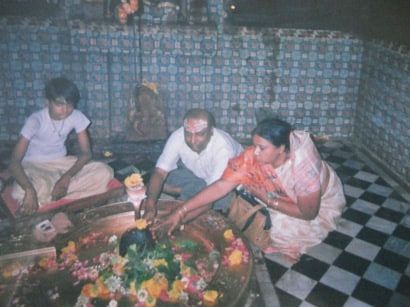|
The worship of phallic emblem is equivalent to all the charitable gifts, sacred rites, holy centres, restraint and sacrifices, In the age of Kali yuga the worship of phallic image is excellent and yield worldly pleasures and salvation. (Chapter 21 Shlokas 24-26)
Prostrations, obeisance with prayers, sacred rites, sins perish immediately. Sins are said to be quelled by virtues. Pranav is in the form of japa and circumambulation is physical rite. Whom worshipped:
Modes of worship:
Why worship:
When Worshipped: The japa of the five-syllabled mantra (Namah Shivay) shall always be performed along with pranava. The practice should start on Chaturdashi day of bright side of moon and concluded on Chaturdashi day of dark side of moon. The months of magha and bhadrpada are the most auspicious on all occasions. Devotee should take one meal only and avoid useless talks and curb all his sense organs. The five syllabled mantra should be repeated one thousand times daily. All the time remembering the various aspects of Shiva who is seated in lotus pose, five syllabled mantras should be done five lakh times and concluding day twelve thousand times. (Chapter 17 Shlokas 36-38) In case in the dark moon of Ashwin month, if Chaturdashi falls on Sunday and Sankranti is with ardra & mahrdra stars, it is very auspicious for Shiva Puja. Shiva Puja on Magh Chaturdashi in the dark moon bestows the cherished desires, longevity, prevents premature death and accords special powers. (Chapter 16 Shlokas 40-42) The worship of Shiva on Mondays together with making gifts in the month of Kartika supresses excessive poverty and increases prosperity. (Chapter 16 Shlokas 51-52) How Worshipped: For the sake of worship, devotee should invite five Brahmins along with wives who are great shiva devotees. One who is excellent who shall be assigned Simba form, others shall be assigned aspects of Shiva viz. Isana, Aghora, Vama Sadyojata. Worship should start as per scriptural code. After conclusion of worship, havan should be should be done with cow ghee and mantra. Devotee should offer one thousand ablution and Brahmins to offer one hundred eight times. At the end of Haven, devotee should wash the feet of Brahmins, offer meals and give monetary gifts. If the householder completes another five-lakh mantra, all his sins are wiped off. If ten million japas are completed in all, he shall become identical with Brahman. (Chapter 17 Shlokas 43-56) At the beginning of the rite, the person should adore Sri Ganesh to ward off the obstacles in performing sacred rite. To ward off all sort hindrances, the person must worship all the deities. There are three types of hindrances – Adhyatimika (ailments of body), Adhibhautika (extraneous to physical body such as due to animals, instects, trees etc.) and Adhidaivika (divine calamities including pandemic, endemic etc.) (Chapter 18 Shlokas 98-106). In common procedure of Shiva’s worship, the eight names of Shiva viz. om Haray Namah; Om Maheshvaray Namah; Om Shambhvaya Namah; Om Shulpanay Namah; Om Pinakgrishe Namah; Om Shivay Namah; Om Pashupatay Namah; Om Mahadevay Namah, shall be used respectively for the rites bringing the clay, making Shivalinga, installation, invocation, ceremonial ablution, worship, craving the forbearanceand ritualistic farewell. Nyasa rite and anganyasa performed. Meditation with mantra Om Namah Shivay (Chapter 19 Shlokas 47-50) The rites in detail are explained in chapter 20 as under:
Sacred fire rite is performed as prescribed in chapter 18: - Shanti yajna needs to be performed to ward off evil effects. Shanti (peace) yajna should be done every year in Phalgun month. Yajna should be done as under (Chapter 18 Shlokas 107-128):
0 Comments
Leave a Reply. |
Archives
July 2024
Categories |

 RSS Feed
RSS Feed